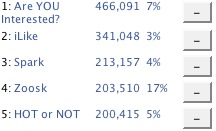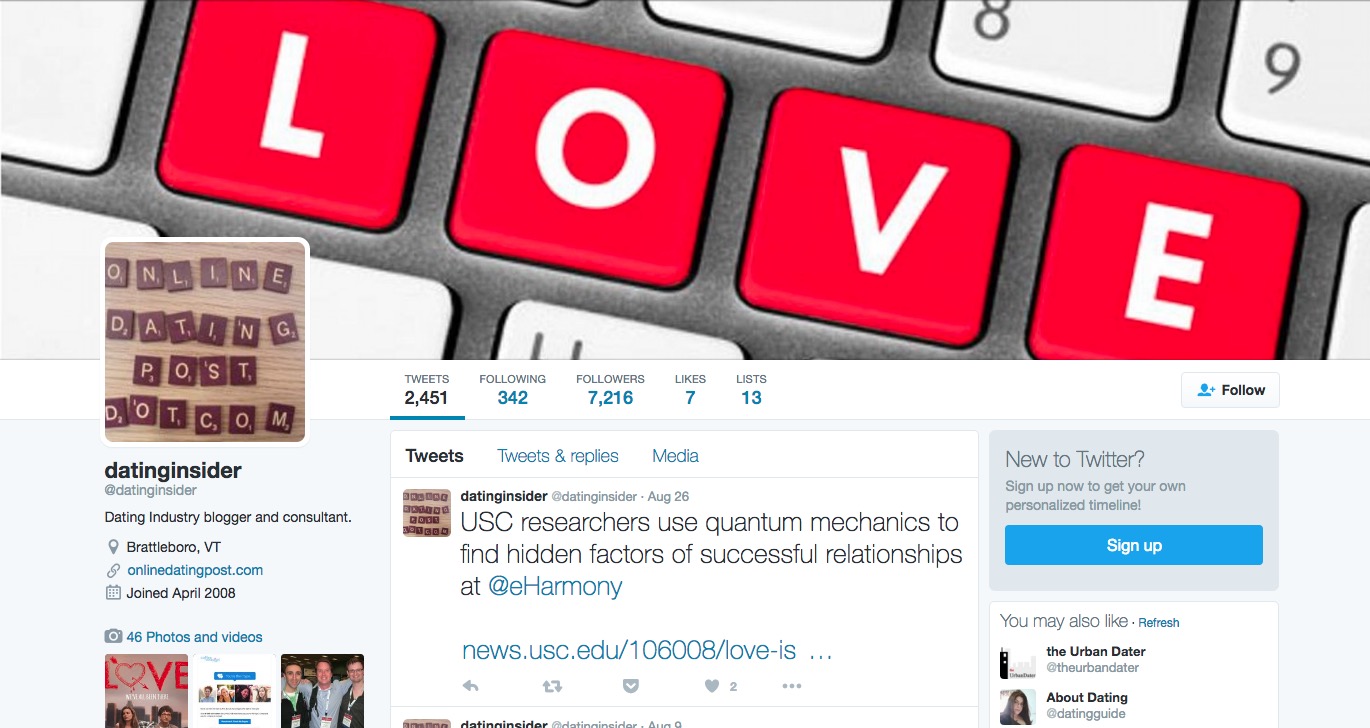 Facebook dating applications (1,414 and counting) are starting to get some serious traction. Recently week I spoke with Alex Mehr, who, along with Shayan Ghazizadeh and two developers, launched Zoosk, a popular dating application on Facebook. Zoosk was funded by Amidzad, which also funds Plugplaycenter, a technology startup incubator for over 100 companies in Silicon Valley.
Facebook dating applications (1,414 and counting) are starting to get some serious traction. Recently week I spoke with Alex Mehr, who, along with Shayan Ghazizadeh and two developers, launched Zoosk, a popular dating application on Facebook. Zoosk was funded by Amidzad, which also funds Plugplaycenter, a technology startup incubator for over 100 companies in Silicon Valley.
Zoosk is a platform agnostic dating application that leverages the social graph to facilitate the dating experience.
Platform agnostic: Runs as an application, widget, embedded feature, etc. The actual application runs on Zoosk servers and is embedded, via various technologies, inside social networks.
Social graph: The global mapping of everybody and how they’re related.
After launching on December 21, 2007, Zoosk boasts 1.8 million installs, with daily traffic ranging in the neighborhood of 200,000 users and 2.5M uniques per month.
The company launched on Bebo on March 2nd. 1,433 users at the moment. The adoption rate at Bebo is much slower than on Facebook.
The Myspace launch was a few days ago. I spent far too long looking for the Zoosk application in the main menu or the menu on my logged-in home page. Turns out it’s here. Myspace applications are still in beta. Most viral growth mechanisms have not been released yet – such as invites, access to newsfeed, etc.
 Zoosk is strongest on Facebook. For those of you keeping tabs on dating site growth on social networks, Appsaholic is like Comscore or Compete for Facebook applications. Appsaholic was created by Social Media. I’m not aware of a version of Appsaholic for Myspace or Bebo.
Zoosk is strongest on Facebook. For those of you keeping tabs on dating site growth on social networks, Appsaholic is like Comscore or Compete for Facebook applications. Appsaholic was created by Social Media. I’m not aware of a version of Appsaholic for Myspace or Bebo.
At first, I had a hard time differentiating Zoosk from Are You Interested, which boasts twice the traffic. User’s won’t notice much difference either, the applications are HotorNot clones with search parameters so you can find people near you built on top of the members of participating social networks. Later on we’ll talk about search aggregation across multiple social networks.
It’s when you start to listen to the plans Alex and the team has for Zoosk, that’s when my brain started to ache and that uncontrollable smile crept across my face, and stayed there.
Before reading on, check out this New York Times article, Piggybacking on Facebook. Talks about a Zoosk competitor funneling 2,000 members a day to a dating site, good background information before we dive into just what makes Facebook such a viral monster.
In order to understand how and why dating sites, or any site or that matter, should be paying attention to the viral nature of social networking, I’m going to outline some of the key features of viral marketing as they relate to social networks.
What is “Going Viral?”
Viral marketing is a lot more involved and complicated than throwing a video up on YouTube. You can hit your brother over the head with a frying pan and get a million views on videosharing sites.
Going viral on social networks begins with users add applications. I may not know about application NextBigThing, but when I visit your Facebook page, I see all sorts of “breadcrumbs” left by the application in your newsfeed and elsewhere. Applications are hardwired to create byproducts like notifications and newsfeed items as users use them.
This leads us to an important definition. According to Zoosk, X-Multiplier is defined as:
The number of new users that are gained as a direct result of activities of an existing users. In other words, let’s say you acquire one customer who, during her lifetime, on average sends out 5 invites to friends and generates 200 newsfeed items. Let’s say the conversation rate of an invitation to a friend is 8% and the conversation rate of a newsfeed item is 0.1%. Then for this one user that you gained, you will acquire:
5*8%+200*0.1%= 0.6 new users
If X-multiplier goes above one (i.e. you get more than one new customer for each customer that you get), the application experiences hyper-growth (exponential growth.) If X-Multiplier is less than one like the above example, the application grows slowly and linearly.
Our holy grail is to optimize the application to achieve an X-multiplier of above 1 and stay there for as long as possible.
To give you an example of one of our hypergrowth periods, on January 2, 2008 we achieved an x-multiplier of over 1. Our user base grew from 707,000 total installs at 12:01 AM on January 2nd to 896,000 users at 12:01 AM on January 4th (around 200K in 48 hours). The X-multiplier dropped below 1 on Friday January 4th and that particular hyper-growth period ended. In general, conversation rates are lower on Friday through Sunday. So on January 4th, because it was a Friday, growth slowed down and x-multiplier dropped below 1.
Keeping the X-multiplier above 1 is the holy grail. Application developers have to rely on the somewhat problematic Facebook application API, which leads to all sorts of unforeseen issues. Given a set of ways your application can interact with user data, what else can a developer to do aim for the <1 X-multiplier? That’s where things start to get interesting. There are a lot of very smart people working on that problem right now. Some of these people are going to become incredibly rich.
Now, what do do with all these users? It helps to think of a funnel. At the top (the wide part), is FB, Myspace and Bebo. The middle are the graduated subscription tiers. At the bottom are the serious singles. With this model, Zoosk can offer something for everyone.
Match is going in this direction, but they jumped right to the pay-to-communicate model. This was a mistake and is why Little Black Book has 27 users. Talk about a missed opportunity. Match can save face, but they have a lot of strategizing to do if they want to move past T&A advertising on social networks and truly benefit from the power of effective, inexpensive viral marketing on social networks. I’ve talked to some of the people involved with the application and I hope to continue the conversation.
Zoosk, unlike Match, started out a simple application, there’s not much to do but click through people. Threw it up, saw what sticked and canned what didn’t. 200,000 daily users vs. 27, just sayin’. Advanced filtering and features are promised in the future and Zoosk is testing fee-based subscriptions.
I have no doubt in my mind that at some point people will pay to bridge the gap between social networks and paid dating sites. Who’s going to win that game is anyone’s guess at this time. It sure is fun to watch though.
Think about Zoosk running on all popular social networks, as well as parter sites and their own destination site. A platform agnostic transparent communication system where people email/wink back and forth, never knowing that other person is on a different social network. A dating service, (née site) that doesn’t have a specific destination, distributed across the Internet. That’s the holy grail of a true open online dating platform.
Of course there are many issues to surmount, and there is nothing stopping other companies like Are You Interested from following Zoosk down this path, but something in my guy tells me these guys have the whole social net viral thing figured out as much, if not more than anyone else in the space.
The idea of aligning with a particular dating brand is going to seem positively antiquated in a few years. Match and eHarmony will continue to spend $120M+ on marketing every year, and smart upstarts will leverage social networks for cheap traffic.
Something tells me that people are more open to checking out new upstarts in the dating space via social networks than older more established brands. It’s just a gut feeling mind you, and I don’t have any evidence to support this, but it’s still a strong feeling.
Now that Mate1 and SinglesNet have ad-spammed us to death, a new company will pop up and replace them at the top of the traffic list any time now. I like that term ad-spam.
Ponder this: What happens when social networks start asking for a cut of the subscription fees dating sites are getting?
In the future, people will be able to export social graph to zoosk.com. That’s going to be incredible. Not that you want to date your friends, but you want to date their friends. Tie in some reputation management tools and you start to have a meta-dating system that blows away anything we’re using today.
As I said, there is not a lot to Zoosk. A few concerns I have:
The flirt options are terrible, glad there is an “other” option where you can type in your own text.
When you are flirting, you can’t get back to the person’s main profile page in the application. either you wink or flirt or they are gone forever, or at least until you cycle around to their photo again.
The Super Flirt feature lets you buy the person a virtual gift. Prices range from free to $1.00 for everything from handcuffs to roses to a beer or boxers. “Hi, I just met you, here is a picture of a pair of boxer shorts.” Weird, but then again I’m old.
I can’t stand that I have to click a link to see the person’s entire profile. but then again, it’s another opportunity to “share” an obnoxious and useless ad with users. I would gladly pay $50 a year to Facebook to get rid of all the ads. Thankfully, I found a cheaper way with Faceoff or this or this one, which can basically strip a Facebook page down to the essentials.
With Zoosk, I’m not sure if I am winking multiple times at the same person. Are they getting bombarded with winks or is only the first one going through? Simple feedback here would be helpful. Again, the application is bare-bones at this point and the profile fields are scarce. Uh Oh, I went to my Zoosk Box, which the rest of the world would call the inbox, and see that I winked at someone four times. Like she is every going to flirt back at this point. Talk about a squandered opportunity.
Luckily the rotation feature doesn’t work very well, so it’s easy enough to see the same people over and over again. Either something is broken or they are doing the repetitive thing for a reason.
Here is some interesting information Zoosk has learned, and continues to learn, about conversions and usage on Facebook. More conversions on Monday vs. Saturdays. Sometimes they don’t know what’s happening. Numbers spike and drop, but what’s the cause? They have a ton of sensors tied to metrics to evaluate value and help with optimization.
Zoosk changes the user user workflow depending on the day of the week. User workflow is the pathway and pages a user takes to use an application. Sometimes they try to add more “invite users” pages to workflow to see what happens. Experimentation is key. I’d love to see the output of that dashboard, so much uncharted territory here and you live and die by your stats and metrics.
Overall, I’m underwhelmed by Zoosk from a user experience standpoint. There are plenty of other applications that do the same thing, with many more people. Zoosk has a chance to be a real game-changer, thats for sure.
Just think, it took years for PlentyOfFish to get 2.5 million visitors a month. Zoosk got 200,000 in only two months.
Leveraging social networks is the cheapest way to build out a dating site from zero members. Keep up with what’s happening at the Zoosk blog. Make sure your Google Alerts and newsreader are tuned into companies like Zoosk and track them with Appsaholic. Over time, trends will start to emerge and we’ll have a better sense of just how effective social networks are for driving traffic. Then we can discuss how my definition of quality traffic probably differs from yours.

